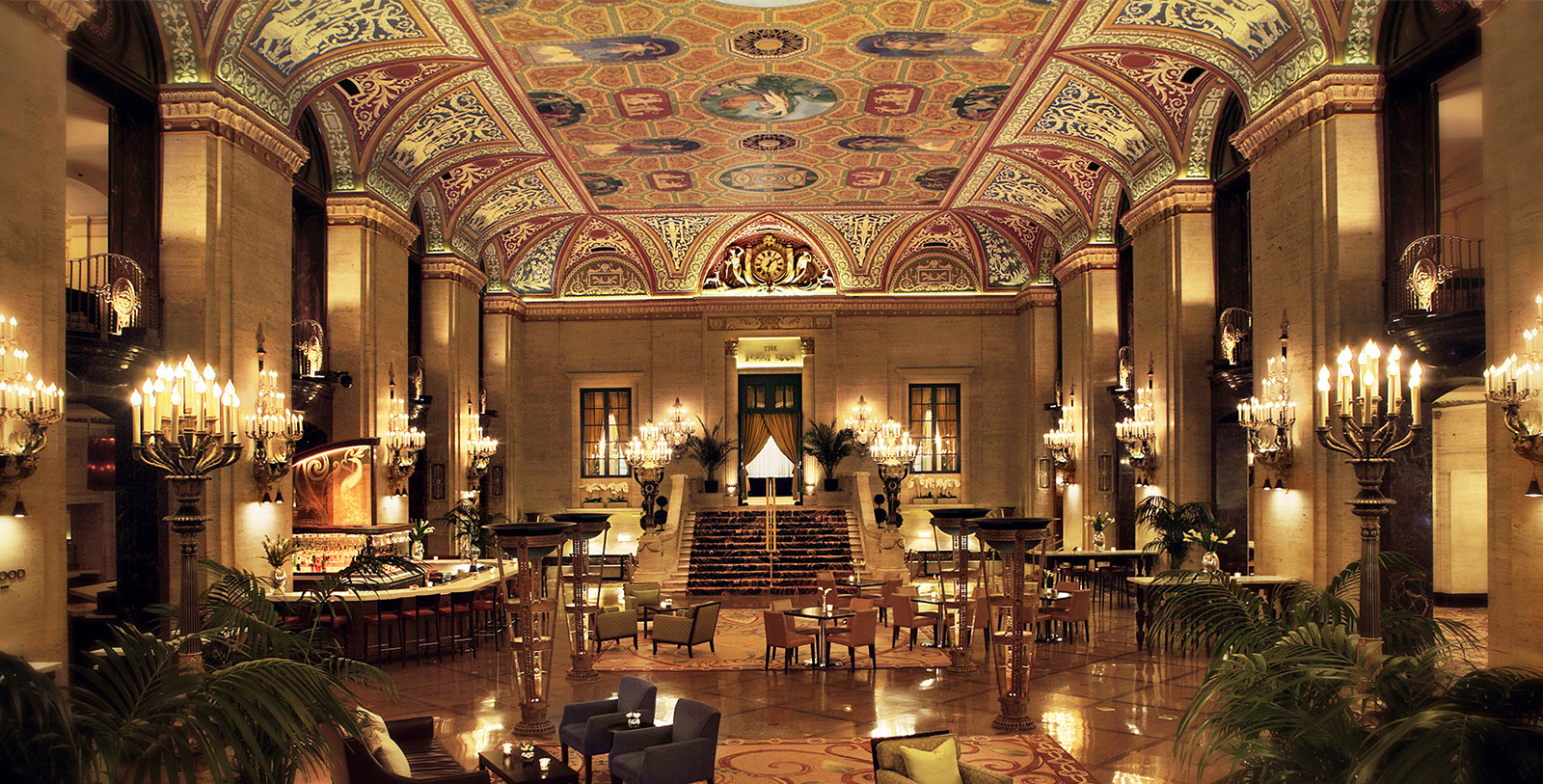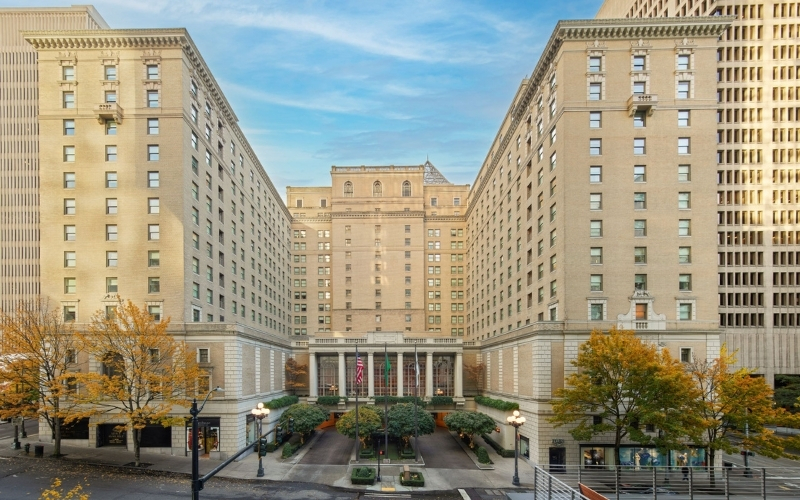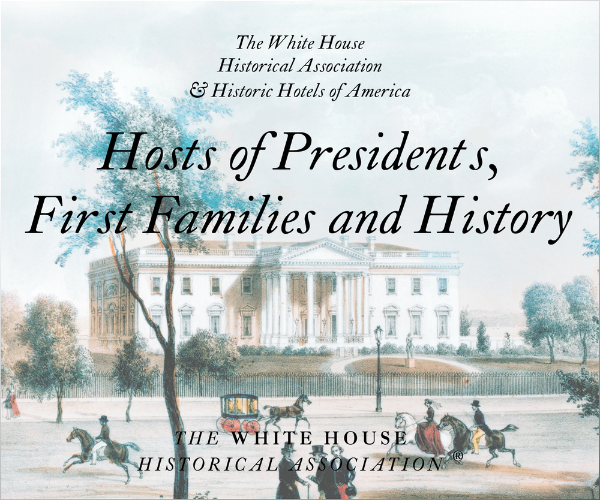The founders of the National Park Service (NPS) understood the need to build spectacular lodging. It not only had to have an appearance that matches the breathtaking surroundings of the park, but it also had to be warmly welcoming since visitors that traveled a long way wanted more than just a place to sleep — they wanted a place to revive and renew. Each of these lodges look like they belong right where they are. You wouldn’t pick one up and move it to another park. They’re at home with their environments.
Old Faithful Inn (Yellowstone National Park)
Where else but Yellowstone would you expect to find the largest log structure in the world? The first national park deserves a majestic lodge, and that’s what it got. Six stories tall, you’ve never seen anything else like it, because there is nothing else like it. It’s really, really big. Old Faithful Inn opened in 1904. And, although it had electric lights — rather than flaunting the technology — the designers went with lights that looked like candles.
Just because the Inn was designed to be rustic 100 years ago doesn’t mean your stay today is going to seem like you’re roughing it. The Inn has been continually improved over the years, with a major update in 2004 to meet current building codes. It’s a comfortable and elegant stay, just a short walk from its namesake, the Old Faithful geyser.
El Tovar Hotel (Grand Canyon National Park)
Charles Whittlesey, principal architect of the railroad that brought tourists to the western parks, designed the El Tovar as a cross between a Swiss chalet and Norwegian villa. Yet, it’s placed in a high-desert pinyon-juniper forest in northern Arizona. This might be the lodge on the list that looks, in places, a tad out of place. Let’s call it “distinctive” and run with that, because history, and our readers, have judged the El Tovar as one of the all-time renowned national park lodges, visited by the world’s most renowned personalities, from Albert Einstein to Paul McCartney.
The view from the dining room is less spectacular than its counterpart lodge on the North Rim, but the food is on another level. And of course, just looking at the magnificent El Tovar is pleasant enough. The hotel is right at the rim, so if you want panoramic views, they are steps away. El Tovar encourages a dress code for dinner, part of preserving its legacy as an outpost of refinement in the wild of the great outdoors.
Many Glacier Hotel (Glacier National Park)
While a Swiss chalet may not look quite at home at the Grand Canyon (I’m looking at you, El Tovar), it’s a perfect look for the Many Glacier Hotel in Montana. The hotel is a line of chalets along the lakeshore of Swiftcurrent Lake. It’s at the base of Mount Grinnell and was built in 1914. It’s not too fancy (plenty of Swiss shields and a large fireplace for décor), but it’s quite functional and lets you focus your attention on the amazing area that surrounds the hotel. With the hotel at its heart, the Many Glacier area is a hub of activity, including horseback riding, boat tours, kayak and canoe rentals, and places to hike, including the Grinnell Glacier.
Zion National Park Lodge (Zion National Park)
Yet another Gilbert Stanley Underwood creation, like others, the Zion National Park Lodge has a central lodge and a surrounding group of cabins with stone fireplaces and porches. There’s also some hotel rooms. Unlike Underwood’s other designs, it was built rather understated — intentionally — so as to not overwhelm those that still resided in the canyon when the lodge was created. Movie fans will recall seeing a bit of the Zion Lodge in The Eiger Sanction with Clint Eastwood. Some serious fans look for the areas in which his character trained, and are disappointed to find out that the pool shown in the film has been filled in. The Zion National Park Lodge set the style for additional structures and development in and adjacent to the park that were needed to meet its stunning growth in visitation.
Bright Angel Lodge (Grand Canyon National Park)
You may have noticed that the Grand Canyon has three lodges on this list. Two of them are massive, spectacular structures designed by leading architects of their day. Then, there is the Bright Angel Lodge — a historic hotel for the rest of us. The Bright Angel Lodge fits in perfectly with its surroundings. It’s made of stone and logs, and landscaped with sage in juniper. It’s not too tall, not too ornate, and at peace with itself. The lodge itself dates back to the 1930s, but it features one room that was built in 1890. Bucky O’Neill was a lawman, judge, gambler, and politician in Arizona. He helped bring the railroad to the Grand Canyon, and built a cabin there, before his death in battle as one of Teddy Roosevelt’s Rough Riders in Cuba. He was not one of the leading architects of his day, but if you’re looking to stay in a memorable cabin built by an extremely colorful character, this is it.
Crater Lake Lodge (Crater Lake National Park)
Crater Lake is a challenging place to build and operate a lodge. The park gets an incredible amount of snow, almost over 40 feet a year. Physically, the winters are brutal. And fiscally, the long winters limit the open season from later in May to mid-October, making the high-maintenance lodge anything but a get-rich-quick proposition. If that sounds challenging, keep in mind that the lodge opened in 1915, when everything about operations was much more difficult. But one important fact keeps Crater Lake Lodge going: The views of the lake and surrounding peaks are awe-inspiring.
Different rooms have different lake views and the best views don’t come with a substantial premium — those views are outside on the patio. Although the lodge is right above the lake and offers breathtaking views, the crater walls around Crater Lake are steep, so there’s no hiking down to the lake from the lodge. The only trail down, the Cleetwood Trail, is on the other side of the lake. After decades of difficult winters, Crater Lake Lodge, like many on this list, has been renewed and renovated. After a visit, you’ll feel the same.
Epilogue: A Bit Of Lodge Trivia
By now, you should see a theme: Most of your favorite national park lodges were built in the early 20th century, have a rustic design, use natural materials from the local environment, and have been refurbished. Despite many having little or no Wi-Fi connectivity, they’re much adored and beloved.
Finally, here’s a little known fact about Gilbert Stanley Underwood’s constructions to impress the rangers you meet at these parks: His lodges built for the Union Pacific were insulated with sawdust and almost all of them burned down. The Cedar Breaks Lodge was never rebuilt. The one at the North Rim was rebuilt well. The Zion Lodge was rebuilt in a hurry with prefabricated units, requiring a remodeling in 1990 to restore its original rustic look.
Discover more historic hotels located within or nearby National Parks!
Read the full article from Travel Awaits here.
About Historic Hotels of America®
Historic Hotels of America is the official program of the National Trust for Historic Preservation for recognizing and celebrating the finest Historic Hotels. Historic Hotels of America has more than 300 historic hotels. These historic hotels have all faithfully maintained their authenticity, sense of place, and architectural integrity in the United States of America, including 44 states, the District of Columbia, the U.S. Virgin Islands, and Puerto Rico. Historic Hotels of America is comprised of mostly independently owned and operated historic hotels. More than 30 of the world’s finest hospitality brands, chains, and collections are represented in Historic Hotels of America. To be nominated and selected for membership into this prestigious program, a hotel must be at least 50 years old; has been designated by the U.S. Secretary of the Interior as a National Historic Landmark or listed in or eligible for listing in the National Register of Historic Places; and recognized as having historic significance.






























